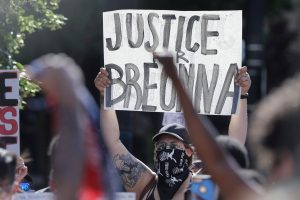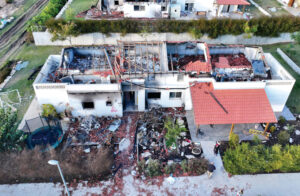1. Ramat Hasharon is flanked on both sides by security facilities. When I was a kid we called them “the factory” and “the camp.” Today they’re called “the Ta’as compound” – using the Hebrew acronym for Israel Military Industries – and “Unit 8200” – referring to the famed elite intelligence unit. Both of these areas have been earmarked as real estate.
My mother used to tell me about the previous residents of these lands – to the east was Abu Kishk, where IMI was set up along with the Morasha neighborhood. To the west was the village of Jalil, which contributed its name to Glilot Junction.
She remembered Abu Kishk as a scary, dark place with barking dogs. Going there was a test of courage. In contrast, the rich sheikh of Jalil, who drove an American car, was seen as a good neighbor and was on friendly terms with my grandfather, who rode a donkey and operated the wells in the area.
My mother remembered a family celebration at the sheikh’s that she and her parents were invited to. “What a razal [beautiful] girl,” the host complimented little Atida Hurwitz, who didn’t speak Arabic and thought he said “what a skinny girl” – raza is Hebrew for skinny.
I found out how the neighborly relations ended years later in an interview with Eliyahu Binyamini, a member of the local aristocracy, son of the first head of the Ramat Hasharon Council, on the eve of his death in 2002. When the War of Independence broke out in 1947, all the area’s Arabs gathered in the elder Binyamini’s yard, the son told interviewer Yoav Karni. “We brought over cars for them and sent them away.”
The Abu Kishk sheikh wasn’t keen to leave, and his family left the furniture in the Binyaminis’ large yard, on the hill near the square. “They assumed they’d be back in a few weeks. In other places they got a kick in the ass, like in Sheikh Munis [today’s Ramat Aviv], for example.”
Binyamini recalled that Sheikh Abu Kishk and his fellahin – farmers – were told by the Higher Arab Monitoring Committee to leave their homes for a few weeks until they would return like victors with the Arab armies. But they lost, and the sheikh died abandoned and impoverished a few years later in Lod, the only one of his clan who was permitted to stay in Israel.
This explanation of the Arab’s departure – that they eagerly left the area and on instructions from above – was accepted in the Israel of my childhood. In our house this was repeated by my uncle Shalom Gutterman, who grew up in neighboring Herzliya. In his service as a guard at the end of the British Mandate era, he knew the neighbors from Jalil and Abu Kishk.
Contemporary historians have found no corroboration or documentation supporting this explanation. Palestinian researcher Walid Khalidi revealed already in 1959 that the story about the Higher Arab Monitoring Committee’s order to flee villages and towns was invented by a Jewish American supporter of the right-wing Revisionists, as fuel for the young country’s propaganda. But its echoes are still heard today in the arguments about the practical and moral responsibility for the uprooting of the Palestinians.
2. In 1988, Benny Morris’ book “The Birth of the Palestinian Refugee Problem, 1947-1949” was published in English and I was sent to interview the author for the newspaper Ha’ir. The first intifada was raging, and on the Israeli side, the “Arabs” were starting to be called Palestinians, with their national aspirations taken seriously.
In this atmosphere Morris and his colleagues, known as the New Historians, offered an amended version of the story of Israel’s establishment. With bated breath I read “The Birth of the Palestinian Refugee Problem” with its harsh descriptions of slaughter and looting by Israeli fighters in Palestinian villages.
There was also the chapter about the Arabs’ departure from Jaffa and Haifa, an upheaval in favor of the Jews in the war’s first months, and the description of Yigal Allon, the Palmach’s commander and the beautiful sabra of the good old Israel, as the chief expeller of the country’s Arabs. Such stories were completely taboo in those days, and I felt I was partner to a big national secret.
I asked my parents what they remembered of those events. My father spoke little about his younger days in the Palmach and the role he played in 1948. He said he fought in Operation Broom in the eastern Galilee, north of Lake Kinneret, in the days before the Declaration of Independence. “We fired into their tents and they fled,” he said, concluding the matter.
After his death I learned that my father had been a mortar operator in the Palmach’s 1st Brigade, under platoon commander Rehavam Ze’evi, “Gandhi,” later a far-right politician. Hebrew Wikipedia says that “on the night of May 2, Palmach troops fired a few volleys of mortar shells at villages north of Rosh Pina that harassed Jewish traffic, and this was followed by a flight from the villages.” Was it 18-year-old Aryeh Bomstein (my father, later the poet Aryeh Sivan) who fired volleys and drove out the residents of the forgotten villages to exile in the refugee camps?
Already in the middle of Morris’ book I understood that the 1948 story isn’t summarized by the argument of “fled or were expelled,” but with the decision to prevent the refugees’ return and to confiscate their land for Jewish towns and villages. The decision was made in the middle of the 1948 war and is in effect to this day. This is the heart of the matter. On this side there’s the Absentees’ Property Law, the Land Acquisition Law, the Jewish National Fund and the Israel Land Authority, and on the other side there’s the Nakba, expulsion, dispossession, confiscation, oppression and their hope to implement a right of return.

It’s impossible to understand the relations between Jews and Arabs in Israel, the Israeli-Palestinian conflict and the failed efforts to solve it, and even the current coalition talks with parties from the Arab community without diving into the history of 1948. The Jewish-Arab schism isn’t the only thing that can’t be understood; planning and construction in Israel are dictated by the land policy designed to perpetuate the results of “Independence and Nakba” – the title of historian Yoav Gelber’s Hebrew-language book – and to make sure the Arabs can’t reverse the situation. That’s the reason for the “population dispersal,” the euphemism for devouring the open territories and filling the area with small, scattered communities, contrary to economic or environmental rationale.
To understand the struggle between the development towns and the kibbutzim, the discrimination against the Jews from Arab countries who were sent to settle the “abandoned property,” one must return to the roots planted in the 1948 wars. The conflict over the Asi Stream and the Mizrahi Democratic Rainbow Coalition’s battles to achieve just distribution of land use are later incarnations of the Nakba.
3. “The Birth of the Refugee Problem” should have been taught in every Israeli high school and in every command course in the Israel Defense Forces. But the fear to talk about the Nakba is rooted in the heart of the Israeli mainstream. It doesn’t exist as a question for the matriculation exam in history or essay writing. There’s no war museum to illustrate the story.
The cadets of Training Base 1 receive no lesson on the Palestinians’ expulsion from Ramle and Lod as a command dilemma. The names of the 400 Palestinian villages that were destroyed, and the neighborhoods that were abandoned in Jaffa and Haifa, Safed and Tiberias, Lod and Ramle don’t appear on the signposts of the towns and other communities that were built and the forests that were planted in their stead. You can find them only on the Nakba app of the nongovernmental organization Zochrot, or in hiking books.
Ari Shavit published his book “My Promised Land” in the United States more than seven years ago. The chapter on the expulsion and massacre in Lod in July 1948, based on interviews with people who carried it out, is at the heart of the work. But the book’s Hebrew edition has yet to come out.
S. Yizhar’s “Khirbet Khizeh,” the story of the expulsion of the residents of a Palestinian village at the end of the War of Independence, is still part of the high school literature curriculum. But education ministers Naftali Bennett and Yoav Gallant, you’ve fallen asleep at your post; this book isn’t required reading as part of Israelis’ intellectual maturing. Only a few get to read it.
Still, the Nakba refuses to disappear – like the houses of the deserted village that appear through the fire in A.B. Yehoshua’s novella “Facing the Forests,” like Arab town Kafr Saba, whose destruction to make way for Kfar Sava drives the plot of Yeshayahu Koren’s cult novel “Funeral at Noon.” The Nakba has gradually taken over the discourse on the establishment of Israel and has replaced slogans such as “making the desert bloom” and “few against the many.”
Nothing did any good – neither the defense establishment’s concealment efforts nor the archives’ silencing, the social taboo among Israeli Jews, the Nakba Law or the right wing’s childish campaign Nakba Nonsense. I drive through the land and see the traces, the sabra hedges that marked the plot borders in the ruined villages, the lone house that remained on the hill near Route 4, the arches decorating the facades on Salameh Street near the Haaretz building. I drive and wonder for how long will Jewish society in Israel ignore these memories.
It’s time to stop being afraid and to tell the truth: Israel arose on the ruins of the Palestinian community that lived here before 1948. We must talk about the Nakba, not only in Palestinian memorial processions to the villages of their fathers and mothers, in small conferences held by Zochrot and in books by opposition historians, but in prime time, in a documentary series like the Hebrew-language “The Inverted Pillar of Fire,” in high school classes and in university lecture halls.
We shouldn’t delude ourselves that the historical debate will determine who’s responsible, which is at the basis of the national narratives – the Arabs, who rejected the Partition Plan and attacked the Jewish community in order to destroy it, or the Jews, who conspired to drive out their weak neighbors and forcibly take over the land, and only waited for an opportunity.
Studying the Nakba won’t alone achieve a reconciliation between the peoples, as the peace seekers hope, nor will it overturn the justification for Israel’s existence and make it collapse under pangs of guilt, as the supporters of the concealing and silencing fear. Their position is tainted by a contradiction. If, as they maintain, Zionism is right, the IDF is the most moral army in the world, the Palestinians are bloodthirsty terrorists and so on, why are they fighting to conceal the past?
A country must not run from its past, even when it’s not pleasant to deal with and raises difficult moral questions. It’s a country’s duty to its citizens, who deserve to know what was here first so they can understand the reasons and motives for what’s happening now – the nation-state law, the repeated failure of the “Anyone but Bibi” parties to create a Jewish-Arab governing coalition, Hamas in Gaza and the Palestinian Authority in Ramallah, and also the Buyer’s Price affordable housing program in the country’s outskirts.
These are all the ongoing results of “the birth of the refugee problem,” the dark part of the War of Independence. We must talk about it.




